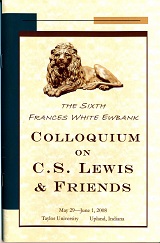Event Title
Session 3-B: The Role of the Imagination in the Work of Lewis and MacDonald
Location
Taylor University, Metcalf 101
Start Date
30-5-2008 2:45 PM
Description
"Living Pictures: Lewis and the Imagination" - Martha Sammons
This paper focuses on Lewis's use of the metaphor of "pictures" and "living pictures" in his fiction and non-fiction. This metaphor conveys his ideas about the purpose of imagination. All Lewis's stories, including The Chronicles of Narnia and the three science fiction books, began by seeing "mental pictures." Then the ideas began to "bubble up" into the story "form." Like a picture, says Lewis, a story should trigger the reader's imagination and emotion. In contrast, Lewis describes "imagining" as dropping mental images once they appear; otherwise, imagination is inhibited. He uses "living pictures" in his stories to "represent" the eternal truth that art can only reflect through static images. The "secondary world" created by the imagination presents the world that lies behind appearances. Because this world is even more real than the world of "fact" we see in space and time, both worlds are necessary parts of the whole truth.
"Forming the Organ of Meaning: - Bill Gorman
In this paper I introduce C.S. Lewis' distinction between "reason as the organ of truth" and "imagination as the organ of meaning" and give some of the background which led him to make this distinction. This is followed by an examination of the implications of Lewis's distinction for Christian formation particularly in the area of worldview shaping, re-shaping ad subverting. Special attention will be given to how Lewis understood reason and imagination and how his relationship with Owen Barfield affected his understanding of the role of the imagination in the knowing process."
"Analyzing the Faerie World as a Model for Christian Spirituality: An Interpretation of Spiritual Progression in George MacDonald's Fantasy Literature" - Jeffrey W. Smith
When studying the works of George MacDonald, one cannot neglect the deep spiritual purpose found throughout his writings. Indeed, it seems that MacDonald never wrote lest he proclaimed what would direct the reader to a greater perspective of the eternal realm. This study will analyze the role of the faerie world in MacDonald’s literature as a plane which his characters must enter and acknowledge as they achieve spiritual union with the divine. Spiritual progression, therefore, will be emphasized with the use of “board-crossings” in MacDonald’s novels and fairy tales. Although MacDonald’s writing should be approached with a broad knowledge of theory, a Christian reading of his work is most crucial. This proposal shall offer further insight into MacDonald’s spirituality with the effect it has had on Christian thought.
Moderator: Tom Moorman
Event Type
Paper
Link to Papers
Living Pictures: Lewis and the Imagination (Not available)
Forming the Organ of Meaning (Not available)
Session 3-B: The Role of the Imagination in the Work of Lewis and MacDonald
Taylor University, Metcalf 101
"Living Pictures: Lewis and the Imagination" - Martha Sammons
This paper focuses on Lewis's use of the metaphor of "pictures" and "living pictures" in his fiction and non-fiction. This metaphor conveys his ideas about the purpose of imagination. All Lewis's stories, including The Chronicles of Narnia and the three science fiction books, began by seeing "mental pictures." Then the ideas began to "bubble up" into the story "form." Like a picture, says Lewis, a story should trigger the reader's imagination and emotion. In contrast, Lewis describes "imagining" as dropping mental images once they appear; otherwise, imagination is inhibited. He uses "living pictures" in his stories to "represent" the eternal truth that art can only reflect through static images. The "secondary world" created by the imagination presents the world that lies behind appearances. Because this world is even more real than the world of "fact" we see in space and time, both worlds are necessary parts of the whole truth.
"Forming the Organ of Meaning: - Bill Gorman
In this paper I introduce C.S. Lewis' distinction between "reason as the organ of truth" and "imagination as the organ of meaning" and give some of the background which led him to make this distinction. This is followed by an examination of the implications of Lewis's distinction for Christian formation particularly in the area of worldview shaping, re-shaping ad subverting. Special attention will be given to how Lewis understood reason and imagination and how his relationship with Owen Barfield affected his understanding of the role of the imagination in the knowing process."
"Analyzing the Faerie World as a Model for Christian Spirituality: An Interpretation of Spiritual Progression in George MacDonald's Fantasy Literature" - Jeffrey W. Smith
When studying the works of George MacDonald, one cannot neglect the deep spiritual purpose found throughout his writings. Indeed, it seems that MacDonald never wrote lest he proclaimed what would direct the reader to a greater perspective of the eternal realm. This study will analyze the role of the faerie world in MacDonald’s literature as a plane which his characters must enter and acknowledge as they achieve spiritual union with the divine. Spiritual progression, therefore, will be emphasized with the use of “board-crossings” in MacDonald’s novels and fairy tales. Although MacDonald’s writing should be approached with a broad knowledge of theory, a Christian reading of his work is most crucial. This proposal shall offer further insight into MacDonald’s spirituality with the effect it has had on Christian thought.
Moderator: Tom Moorman


